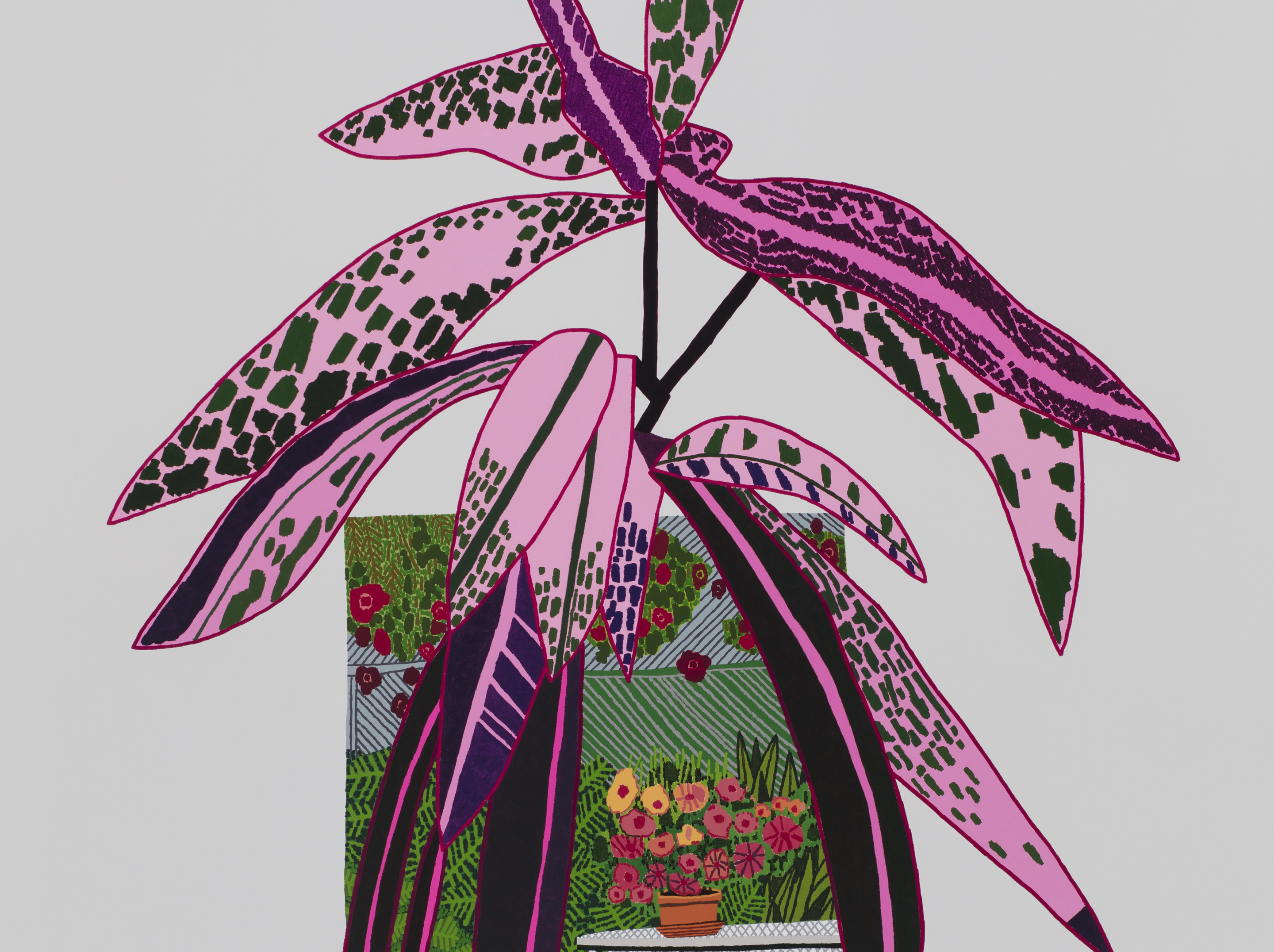This October, Jonas Wood will be celebrated as the 2017 honoree artist at the 19th annual TWO x TWO for AIDS and Art Gala in Dallas. The event, hosted by collectors Howard and Cindy Rachofsky, benefits amfAR and the Dallas Museum of Art, and has raised over $68 million to date.
In advance of TWO x TWO, Whitewall spoke with the Los Angeles–based Wood. He was preparing to move out of his studio, which he happened to rent from artist Ed Ruscha and share with his wife, artist Shio Kusaka. Wood primarily paints while Kusaka works in ceramics, but, working nearly side by side, the two have been appropriating each other’s work for years. The result is part of a current show at Museum Voorlinden in the Netherlands, “Shio Kusaka and Jonas Wood” (on view through January 7, 2018).
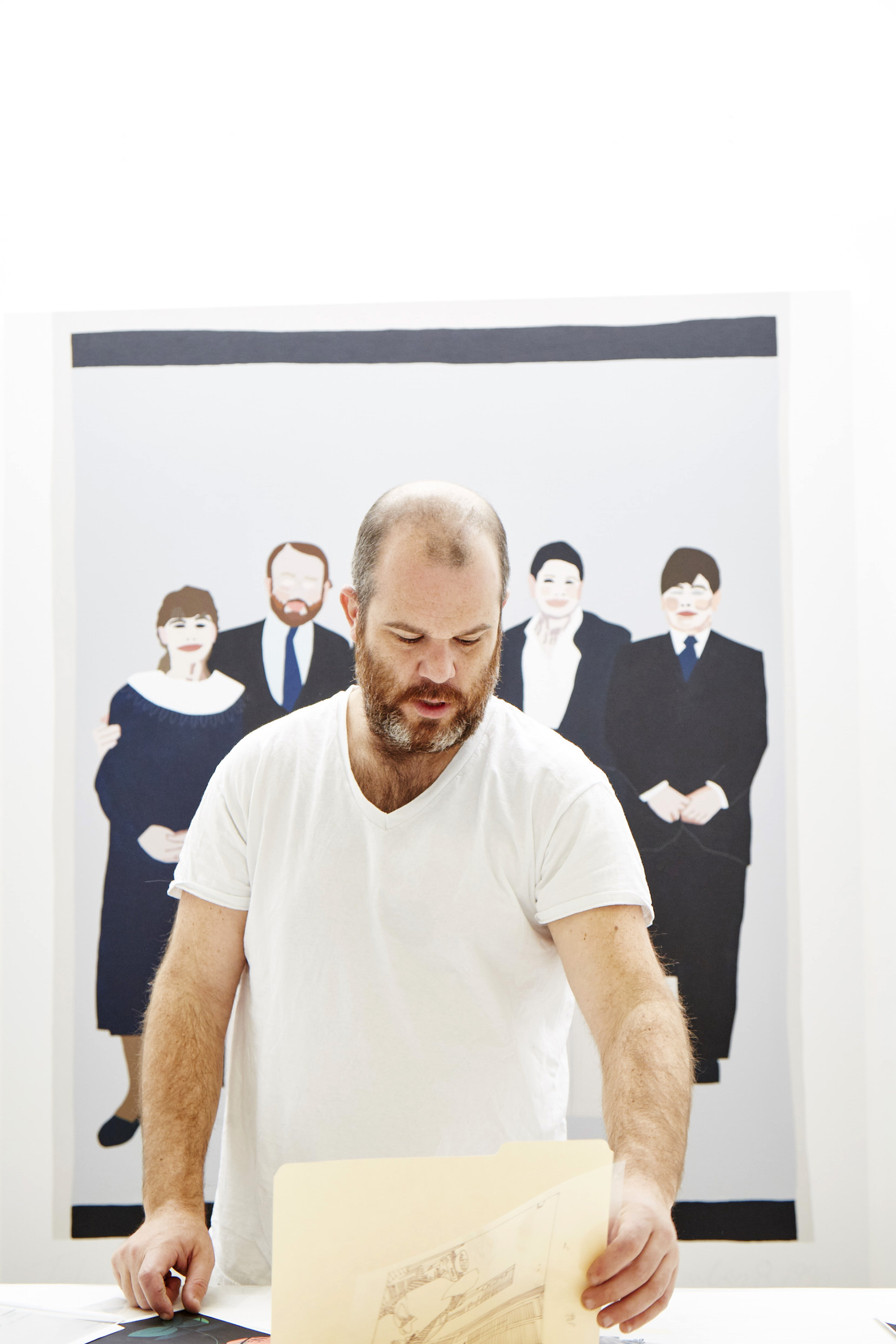
Portrait by Manfredi-Gioacchini.
Wood’s colorful, flat paintings depict interiors, landscapes, vessels, plants, and other images the artist enjoys—like basketballs, baseball cards, portraits, and more. When we spoke with him, he related his work to abstract painting and finding balance in shape, color, and pattern. He works from a range of sourced images, which are sometimes personal, sometimes not. This November, his solo show “Interiors and Landscapes” opens at David Kordansky Gallery in Los Angeles.
WHITEWALL: Congrats on being named the 2017 honoree artist for TWO x TWO. Can you tell us about the painting you made for TWO x TWO, Pink Plant Patio Landscape Pot?
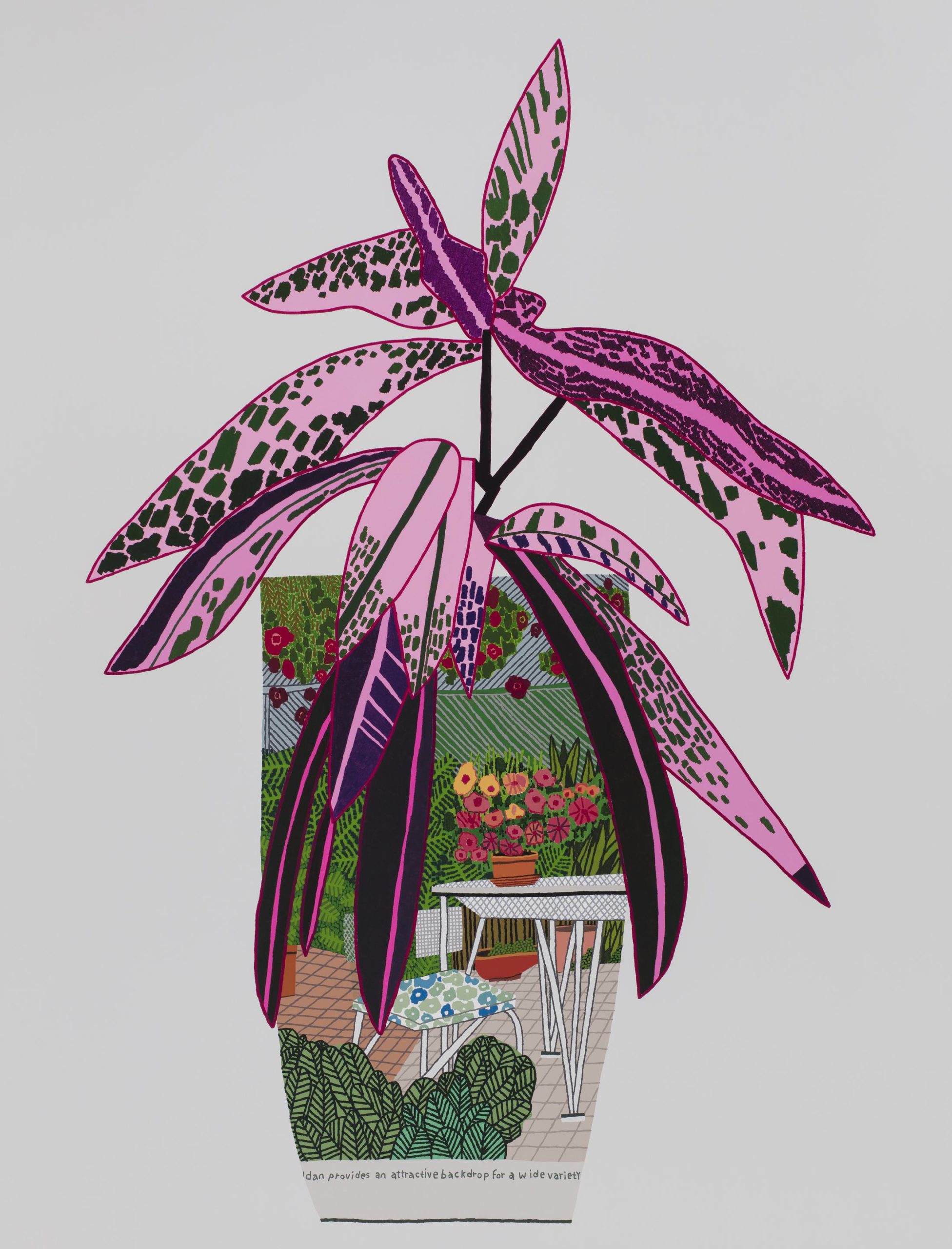
Jonas Wood
Pink Plant Patio Landscape Pot
2016
Oil and acrylic on canvas
118 x 90 inches
Photo by Brian Forrest
Courtesy of the artist, Anton Kern Gallery, New York; David Kordansky Gallery, Los Angeles; Gagosian Gallery; and Shane Campbell Gallery, Chicago
JONAS WOOD: It’s a landscape pot painting I made in late 2016, and it is from a series of paintings I’ve been making for the last couple of years that combine a clipped-out plant with a make-believe pot. The pot is an image from an interiors magazine that’s cut into the shape of a pot. The image has a bunch of plants and chairs and tables in it. It’s like a dual plant-on-plant situation.
WW: Have you participated in TWO x TWO before?
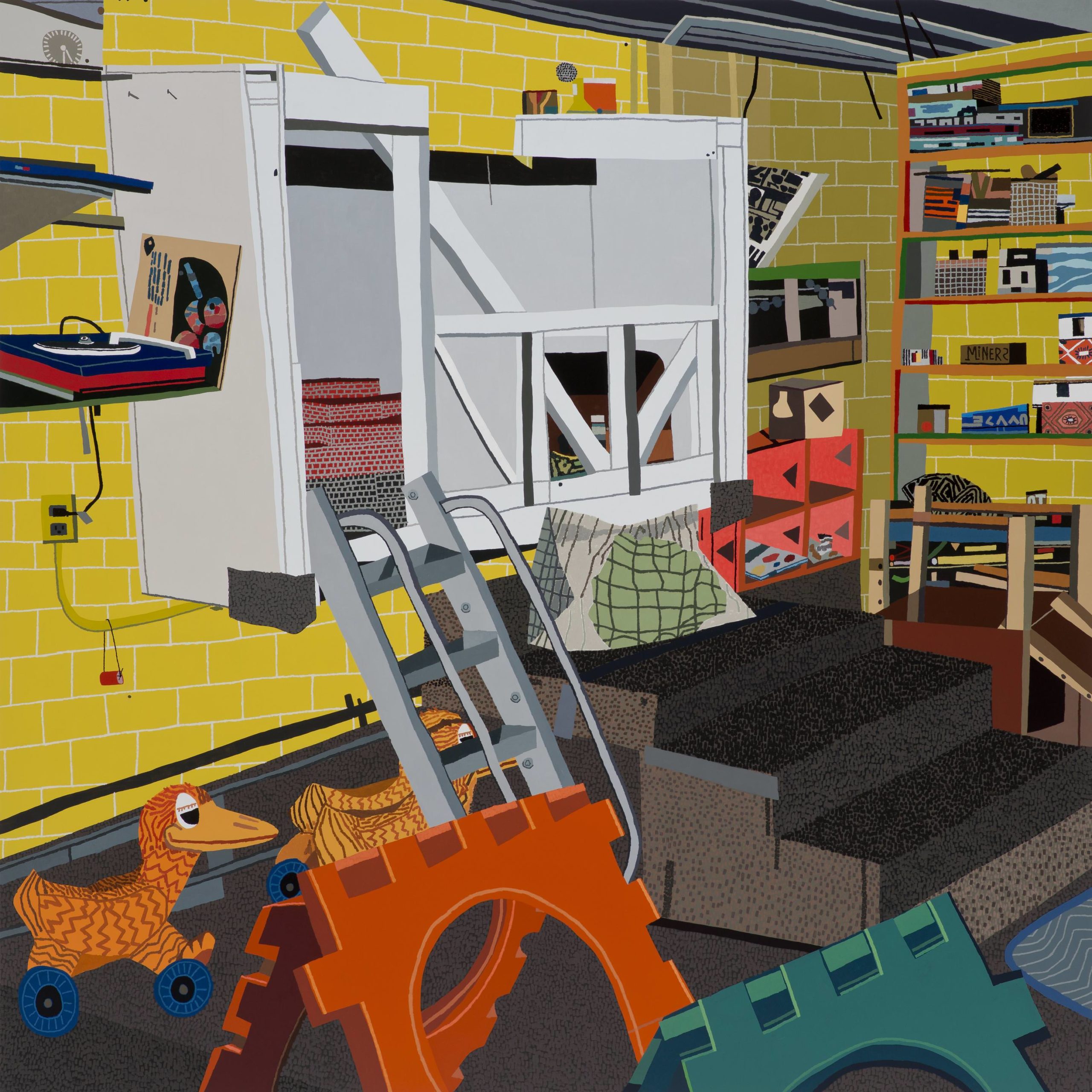
Jonas Wood
Children’s Garden
2015
Oil and acrylic on canvas
93 x 93 inches
Photo by Brian Forrest
Courtesy of the artist and Gagosian Gallery
JW: Yes, a couple of times. This is going to be the third time I donated a work.
WW: Last year’s honoree, Laura Owens, you’re close with, too, right?
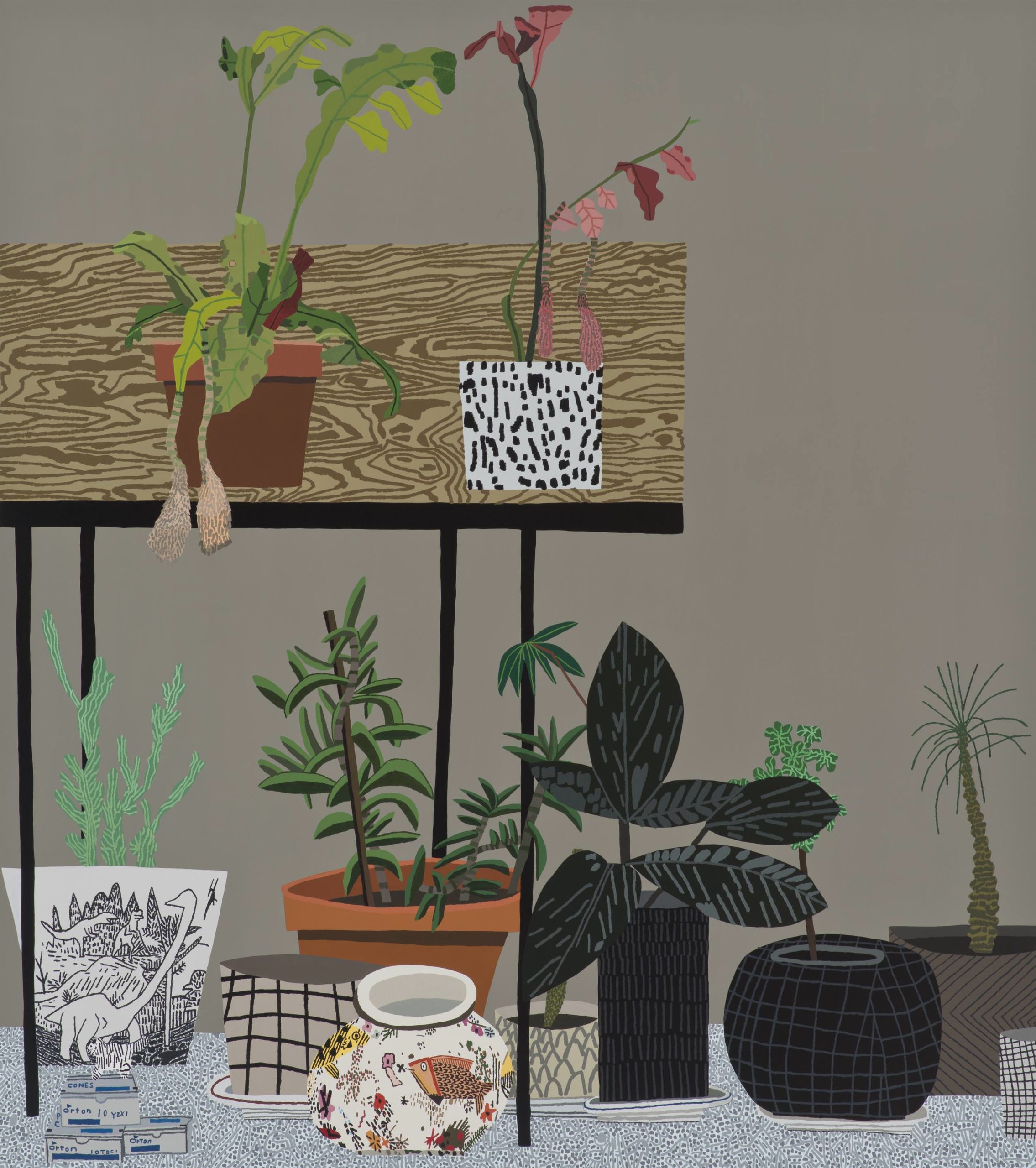
Jonas Wood
Night Bloom Still Life
2015
Oil and acrylic on canvas
90 x 80 inches
Photo by Brian Forrest
Courtesy of the artist and Gagosian Gallery
JW: I worked for her when I first moved to Los Angeles and now we’re friends. She’s awesome.
WW: This fall you have a couple of shows coming up, in September and November. Let’s start with the one in September at Museum Voorlinden, which is a show of your and your wife’s work.
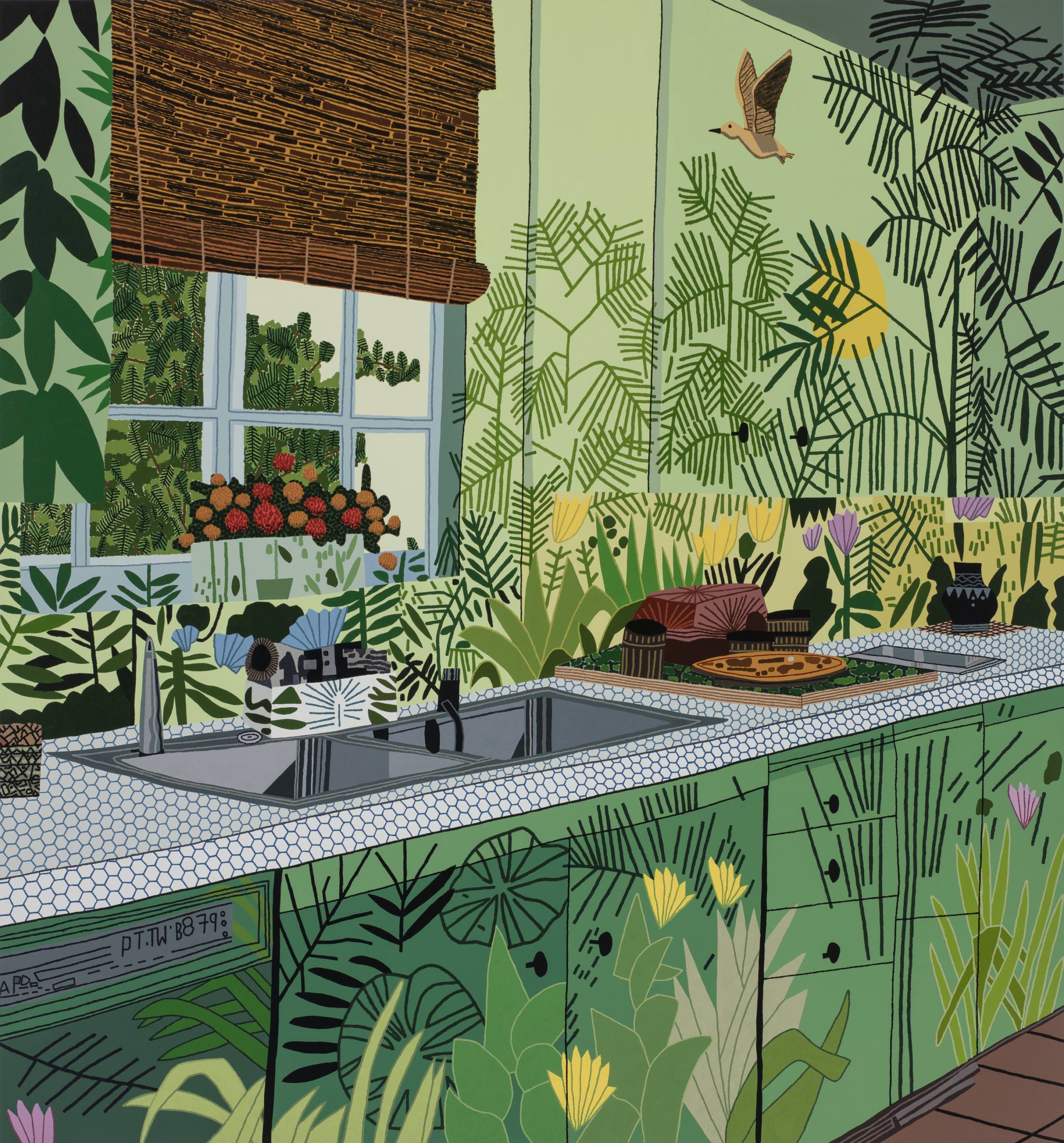
Jonas Wood
Jungle Kitchen
2017
Oil and acrylic on canvas
100 x 93 inches
Photo by Brian Forrest
Courtesy of the artist and David Kordansky Gallery, Los Angeles, CA
JW: It’s about how our work intersects. I make a lot of still lifes that include my wife’s pots and singular paintings that are based on some of her pots. So there are a few places where our work coincides.
WW: Have you shown with her before?
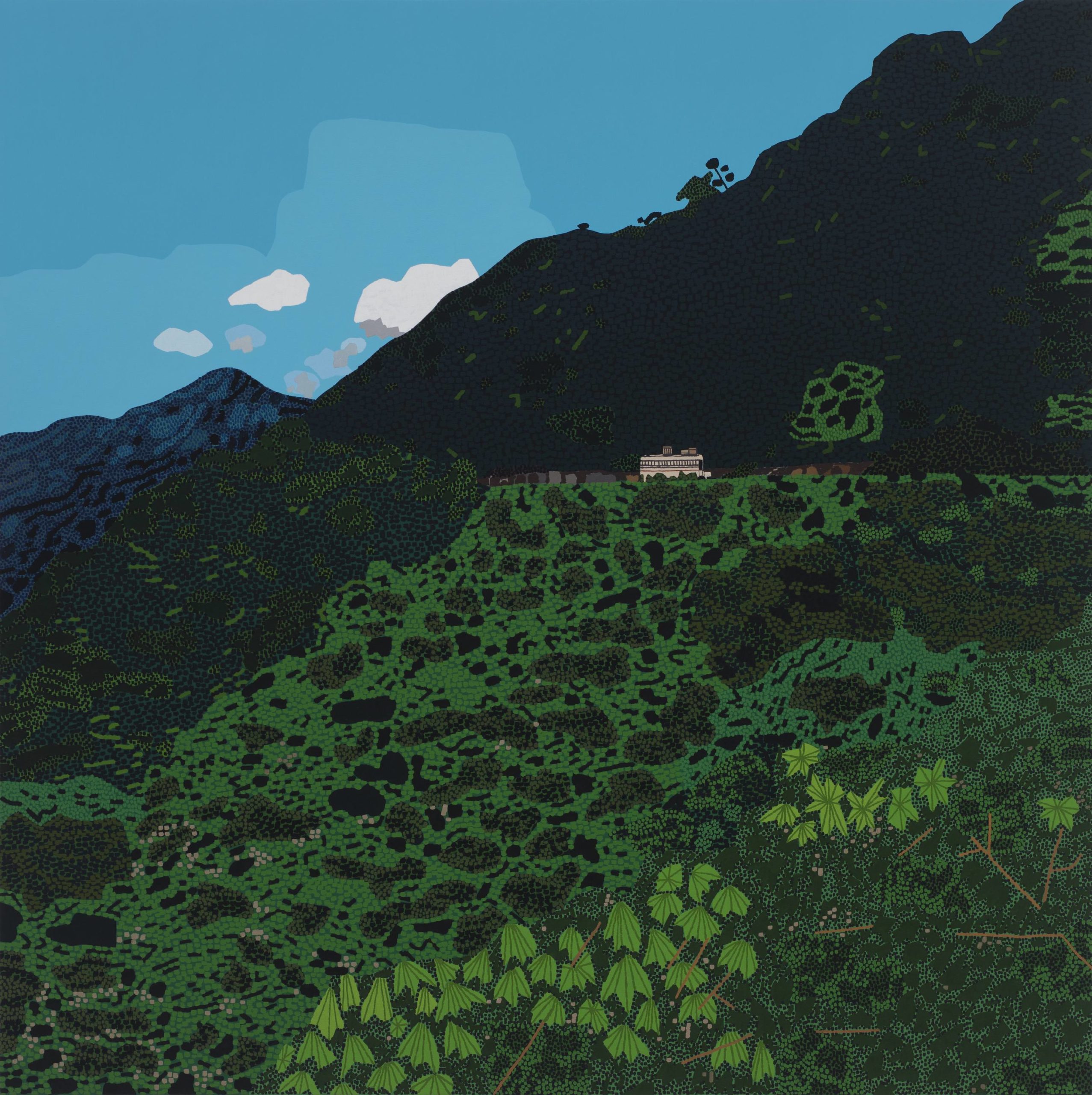
Jonas Wood
Romancing the Stone
2017
Oil and acrylic on canvas
65 x 65 inches
Photo by Brian Forrest
Courtesy of the artist and David Kordansky Gallery, Los Angeles, CA
JW: Yes, first we did a show together in Hong Kong at Gagosian. Brendan Dugan at Karma in New York made a really amazing book, and so then we did a follow-up show at his gallery. So this will be the third time we’ve shown together. This feels much bigger—it’s 10,000-plus square feet.
WW: Your studios are right next to each other. What’s that like?
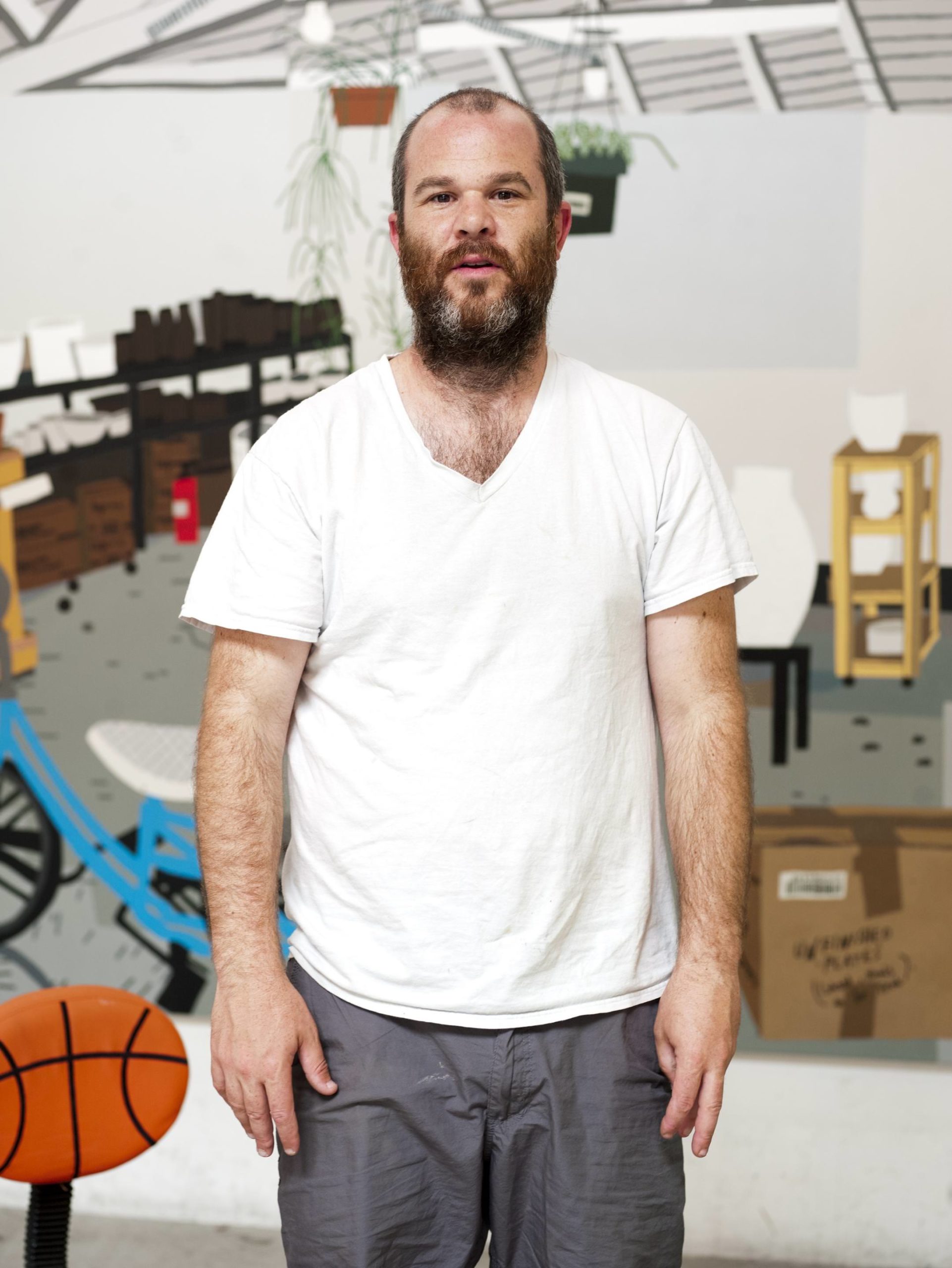
Portrait by Manfredi-Gioacchini.
JW: We share a studio and I’ve been appropriating her pots for a while, using them as still life objects. Once in a while I would make up a new pot with a pattern on it and she would copy it. It was mostly a one-way appropriation for a while. But in the last couple of years, she started appropriating my work a lot more. She made basketball pots and then she started making Greek pot vessels with dinosaurs, which coincided with my interest in making Greek pots. She made some witch pots based on collaborative drawings of witches I made with my daughter during Halloween. She’s put other doodles of mine and painting references of mine on her pots as well.
It goes back to when we first got together. Before I met her, I would only look at painting in museums. I wouldn’t look at vessels or pottery. But after we got together she introduced me to pottery and I started looking at it more. I became interested in using it as a subject in paintings. We’ve never made a collaborative work. The ideas are collaborative, but we haven’t physically gone back and forth and worked on the same objects.
WW: Do you see that happening in the future?
JW: I totally want to make some paintings physically on her pots.
WW: When she started introducing you to looking at pottery, what did you like about vessels? What made you want to paint them?
JW: We went to New York when I first started showing there in 2007. I went to The Met and started looking at pots with my wife, and was really into Greek pots, especially the orange-and-black ones and the simplified language on them. I started making sketches of those. I thought they were interesting; they have a Matisse quality to them, too. Everything is flat because there is no rendering, which is also relatable to my painting because there’s not much rendering in my painting. It’s very flat. I got back to my studio and made more drawings and paintings. That’s how all my work works, really. I paint things that I’m attracted to or that interest me.
WW: In November you have a show at David Kordansky, “Interiors and Landscapes.” You’ve done those kinds of paintings before, but is there a new approach to this series?
JW: That is all new work. It’s going to be 13 paintings—six landscapes, six interiors, and one self-portrait that’s also an exterior. And it’ll be in all three of the gallery’s spaces.
I’ve worked in these genres before. I think the new thing, in general, is that my way of painting is ever-evolving. It’s not exactly the same. I’m always thinking about how I can paint things differently. How is my idea about applying the paint changing? That’s not easy to put into words. What is new is that I’m doing a themed show of just these two kinds of subjects, which I’ve never done before. It’s focused. I’m excited to see them all together.
WW: When you’re working on them, are you focused like that?
JW: I work on a lot of things at once because I don’t like to be forced to finish one thing at a time. I like to be able to pick and choose what I want to do each day so it feels fresh. I think it’s just natural for my style or my personality to be able to wake up and think about what is going to inspire me the most that day.
I like the idea of something just about to be finished and something just about to be started—it feels very natural. I do paint series of works, but I don’t paint things start to stop in a series.
WW: You paint a good deal from sourced images. Can you tell me about how you source images and how you edit them?
JW: I work from photos and sourced images. So for this show, I conceived the idea of doing a bunch of landscapes and interiors. The first step is just to look at all the pictures I’ve been collecting or pinning up on my wall. And then I start to edit them down to just a few of each. There isn’t an overall theme; it’s more that aesthetically these six landscapes or interiors will be interesting together.
Some of them are from parts of my life and childhood, family photos; others are found sourced images. There’s a photo of the interior of my wife’s studio next to mine. And there’s a snowy landscape from when I grew up, at my parent’s house in their backyard.
I compile tons of images, take pictures, print things out I find, and then a big part is editing and sorting. I don’t make 20 paintings and destroy 10. I look through thousands of photos and meditate on images and pick things that I know that I’m going to love before I start them. My paintings aren’t freestyle—they’re more like constructing a building. You want to have a good foundation. I make a lot of drawings of paintings before I make them into paintings.
WW: Is drawing for you, then, your way of working stuff out before the painting?
JW: Yeah, but I make very well-rendered drawings of paintings and sometimes the drawings turn out so well I use the drawing as the model for the painting. The other half of the time I’m using source images as models. It goes back and forth.
WW: In a few past interviews, you’ve talked about the challenge of color and in seeing color, that a plant is maybe more blue than green, for instance, and then the challenge of pattern, too. You related that to wanting to make those difficult things enjoyable for you. Is that what draws you to the colors you choose and how you work with pattern?
JW: I use photos and source material to make my paintings, but I’m not a photorealist. I’m using the shapes of the different planes and the spacing of how things are laid out in the photo. I’m referencing some patterns that are in there or making things simpler. I think it’s more about invention. It’s almost more like an abstract painting. There’s no image to reference in an abstract painting—it’s about color, balance, pattern, and technique. So even though I’m painting something realistic (it’s obviously a creation of an idea of something that’s real), I’m relying on the balance of color and geometry and pattern-making to be able to have things work. My paintings are super-flat, so this involves micro-patterns and shapes and colors that all come together with your eye to create an image.
WW: Your recent show at Gagosian in San Francisco, “Notepads, Holograms and Books” [March 30–June 17] was of paintings on blown-up notepads. Can you tell me about putting together that exhibition, which was a dual show with Ed Ruscha, who is also your landlord, right?
JW: Yup, he’s my landlord. I’m about to move out of this building, but I’ve been renting from him for almost 11 years. We bought a building on a dif- ferent side of town we’ve been fixing up that’s going to be a big compound. I’ve known Ed for a long time, but I never really wanted to bug him. We became friendly over the years and then I started showing with Gagosian and I talked to Ed about it a little bit. He supported my work for years and he introduced me to printmakers. About a year and a half ago, one of the people I work with at the gallery was like, “Do you want to do a show with Ed?” And I was like, “Of course! As long as that’s what he wants to do, I would love to!” And they said they’d talk to him. He was super-nice and was like, “Yeah, that sounds good. Why don’t I come over and talk to you about it?”
He came over and I told him I was making these notepad paintings, and I said, “What would be really cool is if you showed some books.” It was an interesting overlap, I thought. Luckily, he was like, “Let’s do something,” and we started talking about how to curate the show.
WW: What was the idea behind the notepad paintings?
JW: When I was going to The Met and making those drawings in 2007, I was staying at a hotel in New York and I would use the hotel’s stationery every day to draw. And they would replenish it every morning. I came back to L.A. with several pads of paper and used them in the studio to make notes and doodles. And that developed into me appropriating that notepad and turning it into the Wood Kusaka Studio notepad. Then I started collecting notepads from my dealers and had the idea to make giant versions of my notepad doodles. I made 100 of them, printed them all out, and made these large notepads by silkscreening the logo onto a canvas and stretching it. Basically, I just made giant versions of the notepads that I had, re-creating drawings in his shorthand doodle painting style.
It was an amazing experience. The show was the day after my birthday. So the night before the opening we went out to an amazing Chinese res- taurant in San Francisco with Ed, and the people from the gallery and some of my friends came up. It was a pretty amazing, memorable life experience.
WW: You grew up outside Boston and your grandparents were collectors. You are a collector now and have said, “I love living with really good art . . . it gives me energy and makes me excited about making stuff.” Do you see collecting as a connection to your grandfather?
JW: Yeah, I definitely have the collecting addiction, but in a good way. I grew up in environments with pretty powerful things, and when I started to show and make a little money I started collecting things I liked. I like to collect stuff and live with stuff and look at it and get excited about it and feel its energy and power. But as an artist who sells work to make a living, I think collecting is also an interesting way to get a deeper understanding of how the whole business works. If you’re an artist, you can’t really go buy young people’s work and then wait for it to go up in value and sell it like half the collectors do these days. I’m going to collect and give to museums or my kids or appreciate it. And the only work that I sell is my own work.
I like to support young artists I find interesting. I like discovering new work that I haven’t seen before and learning from it. I don’t trade that often, because I think it’s really hard to get an A-plus work in a trade. It’s easier to get an A-plus work in a show or at auction. I’m not into trading just to say I have somebody’s work. I want the good shit.



